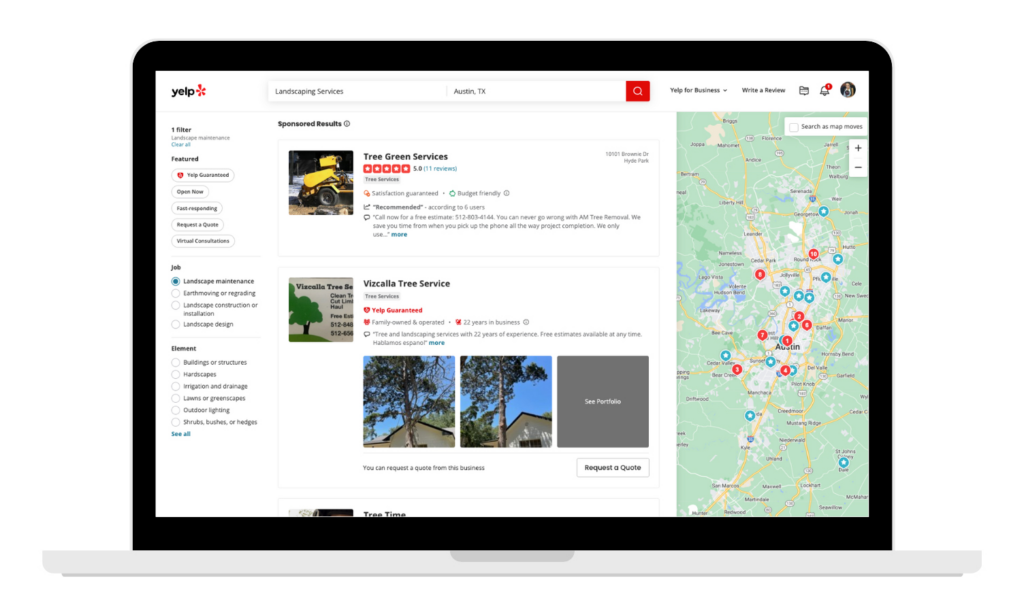Best places to advertise your small business online
The oldest way for local businesses to reach new customers—and in many ways still the best—is paid advertising. But advertising has progressed well beyond a print ad in a local newspaper or local listings on the Yellow Pages. Connecting with potential customers today requires knowledge of behavioral and geo-targeting, content creation, conversion metrics, and much more.

As a small business owner, navigating the world of digital marketing can be overwhelming, but with the right marketing strategy, it doesn’t have to be. Build a strong foundation for your online presence by exploring the best places to advertise your small business and learning which types of digital advertising work best for you.
Benefits of online advertising
Online advertising has come a long way from flat, static banners on a webpage. It can do so much more, from tracking consumers across multiple devices and following up on abandoned digital shopping carts to helping you show up first in search engines through search engine optimization (SEO.) Online advertising offers the following benefits:
- Helps you reach your ideal new customers using advanced targeting capabilities that help you identify and connect with specific audiences.
- Supports your organic marketing efforts, or business promotion services that you don’t have to pay for, such as your website, blog, email marketing, or word-of-mouth marketing (reviews and referrals).
- Gives you valuable information to adjust your messaging, including insights on customer demographics to help you identify your local customers and metrics to gauge your ad campaign’s success.
Choosing the best place to advertise your business
With so many cheap ways to advertise online, it may be overwhelming to decide where to focus your efforts. Before you commit to a new digital marketing strategy, make sure you understand each advertising platform and consider your target audience. The best place to advertise your business depends on your unique marketing goals, budget, and audience.
Explore eight of the most popular places for small business digital advertising, along with marketing tips for making the most of your budget.
1. Yelp
People turn to Yelp to find great local businesses, and while Yelp is well known for its customer reviews, it is more than just an online directory or review site. Yelp also offers advertising solutions that help local businesses get in front of users who are searching for products or services like yours.
With Yelp Ads, your business is displayed in a number of key places on the site and app, such as above or below relevant search results in the “Sponsored Results” sections and on your competitors’ pages. This means customers are more likely to find you while searching for the services you offer—and more people finding you means more leads for your business: Businesses with Yelp Ads get 4x more leads on average.*

On Yelp, you can target specific audiences through keywords—terms and phrases that match what customers are searching for and describe the services you provide. Boost keywords that are important to your business and target the services that matter most to you. You can also block certain keywords if there are adjacent keywords for services you do not offer.
Yelp Ads follow a price-per-click (PPC) pricing model. You can adjust, pause, or cancel your ad campaign at any time, and you’ll also have access to the ads dashboard where you can track key metrics and measure the success of your program.
To create your Yelp Ad, follow these easy steps:
- Set a goal for your ad campaign, such receiving as more phone calls or website clicks
- Choose your ad photo—or let Yelp choose for you
- Write ad copy that shares what’s special about your business
- Select keywords to boost, meaning your ad will be more likely to be seen by customers searching for these keywords and related searches
- Choose the map area where your ad will be shown
- Set your daily average budget, which you’ll never exceed
Pro tip: Before you launch your ad campaign with Yelp, fill out your Yelp Business Page. The top three things consumers say are important when choosing a business on Yelp are the ratings and reviews, photos and videos, and critical business contact information (phone, website, address).** Potential customers want to know everything about your business as they decide where to spend their money, so make sure your page gives them all the important details, from your contact information to your business origin story.

My formula to success is simple: Focus on the lifetime value of customers. Yelp is unique in that it provides me with customers who are loyal and drive strong long-term returns. Beyond utilizing the platform to gauge our performance via reviews, I find tremendous value in Yelp’s local ads and Request a Quote feature, which I rely on for a steady inbound pipeline of leads.
— Josh Campbell, owner of Rescue Air and Plumbing
How Rescue Air uses Yelp to capture leads and drive long-term ROI
Get more leads
Reach more customers with placements on search and competitors' pages.

2. Google
Google is one of the most popular platforms for paid search advertising, making it an important marketing tool for small businesses. Paid search ads appear in prominent places, like above or beside the organic search results. When customers search for a product or local service, these ads give you the opportunity for you to capture their attention and direct them toward your business website.
Google’s Search Network
Google’s paid search advertising follows a pay-per-click (PPC) pricing model, which means you only pay for ads that customers actually click on. With Google Ads, you can pay for your ad to show up in several key places:
- Above or below Google search results
- Beside, above, or below search results on Google Play, in the Shopping tab, and Google Maps, including the Maps app
Google Ads allow you to target specific keywords, or the words people search for when looking for a product or service. To get your ads to appear for the most relevant audience, you need to choose keywords that match their search terms. For example, if you’re a landscape company, you can target keyword phrases as broad as “lawn care service” to “hire company to remove trees.” You can also exclude keywords to make sure you don’t show up in searches for products or services you don’t provide—for a landscape company, this might mean excluding “pest control.”
You can also target by your audience’s interests, search habits, and location, so you show up in local searches that will be the best fit for your business.
Pro tip: To make your keyword research more effective, use free keyword research tools to brainstorm popular search terms related to your brand. Plus, you can use the same keywords to improve your website’s search results ranking for free using search engine optimization (SEO).
Google’s Display Network
Google also offers an advertising service called the Google Display Network, where your advertisement shows up on more than 2 million websites outside of Google. You can target your ads using keywords or audience demographics, or you can choose to show up on specific websites that your customers visit.
Focused on free online business advertising? You can sign up for a free Business Profile on Google (formerly Google My Business.) Your Google Business Profile includes your essential business information—such as your phone number and business website—as well as photos and more features to help you stand out when people find you on Google Maps or Google Search.
3. Facebook
Social media marketing is one of the cheapest ways to advertise your business online. If your marketing goal is to reach diverse, specific audiences with minimal ad spend, Facebook ads are a good place to start. Facebook (or Meta) is the most widely used social platform, with over 3 billion users across diverse demographics.
You can choose to target audiences based on age, gender, location, and personal interests, or you can retarget customers who have already shown interest in your business through actions such as visiting your website or engaging with your Facebook business page.
Facebook offers a variety of ad types that can drive people to your website, engage with your Facebook business page, or sign up for your email list. Choose between:
- Photo ads that display in a user’s feed
- Video ads that play before organic videos or in a user’s feed
- Boosted Facebook Stories
- Messenger ads that allow you to message customers directly
Facebook ads operate by an auction system, in which the platform pairs each ad with the users who are most likely to be interested in it. But unlike traditional auctions, when the prize goes to the highest bidder, other factors influence your ad’s success, including your ad campaign’s budget, schedule, design. According to Facebook, good creative can actually help an ad win out over competitors with higher set budgets. For the best results, design ads with compelling visuals and copy that tells your brand’s story.
Once you design and launch your ad, you can monitor its success with detailed campaign metrics, such as your cost per click, post engagement, and conversion rate for leads.
Similar to Google’s Display Network, businesses can also use Facebook’s Audience Network to create display ads—such as the banner ads that appear on the top, side, or bottom of a website—to target audiences on sites outside of Facebook. While this tool has extensive targeting capabilities, it has a lower conversion rate than other social media ads. Use this only as a springboard if you’ve already had success with Facebook ads.
4. Instagram
Instagram ads are typically posts that brands can pay to boost to expand their reach or target specific audiences. You can target your ad using audience information like location, interests and more.
Before creating an ad campaign from scratch, you can choose to boost any of your existing content on Instagram, including:
- Image or video posts
- Carousels, which include multiple images
- Reels
- Stories
Boosted ads look just like the rest of Instagram’s content, plus a note that says “sponsored” and a call to action, such as “Shop now.” These ads are ideal for e-commerce shops and other local businesses that want to share tips, tutorials, or make time-sensitive announcements about sales or local events.
Since Instagram is a highly-visual platform, your ad campaign should include compelling visuals—whether it’s before and after videos of the different projects you’ve completed, images of your staff in branded attire, or behind-the-scenes footage of you packaging new products.
Pro tip: When creating ads for different social media platforms, make sure to customize your message for each site. For example, Instagram has a younger demographic, so keep the tone of your ads casual and conversational, rather than promotional.
Instagram is also one of the best places to experiment with influencer marketing—paying an influencer to make endorsements or sponsored content about your brand—to complement your other advertising initiatives. Make sure you do your research before you decide who to work with, and remember that more followers isn’t necessarily better: As a small business, look for micro-influencers (about 10,000-50,000 followers) who have a following in your local community or expertise in your specific niche.
When you’re thinking about your overall marketing plan, influencer marketing to me is like the cherry on top. It’s going to be that thing that takes you over to the next step. But it can’t just be influencer marketing—that is not gonna work. You have to have a solid 360 marketing plan.
— Crystal Chase, digital marketing consultant at C.Chase Consulting
5. X (formerly Twitter)
As a highly conversational platform, X is ideal for making organic content—meaning free promotion for your business. However, if you want to expand your reach on X, the platform does offer several options to advertise your local business online:
- Image ads showcase a product or service
- Video ads tell your brand’s story
- Carousel ads consist of six swipeable images or videos
- Text ads look like a standard tweet, but expand the reach of your organic content
If you opt for a text ad, keep in mind that you’ll be creating native advertising, or content that doesn’t feel like an advertisement. The intent should be to entertain, educate, or engage with your target audience—and not just make a sale.
Not sure if X ads are for you? Start by making organic content that establishes you as an expert in your field and boosts brand awareness. Monitor events and trends so you can be a part of the conversation, and follow these tips for best practices while tweeting:
- Use hashtags to link related content
- Keep your copy short and sweet
- Use visuals (images, GIFs, or videos) whenever possible
- Make clear calls-to-action, such as “follow me” or “subscribe to my newsletter today”
- Use polls and ask questions
If a tweet performs well, then you can consider promoting it with text ads. Make sure to support your claims with facts, research, or customer testimonials.
Your customer is wherever you feel most comfortable. I think a lot of times as business owners, we think we need to be in 30,000 places at once, instead of just choosing the platforms you feel most comfortable with, where you can be your most authentic self. Your audience is where you are.
— Kirstin Lawrence, former associate manager of customer success at Twitter
Watch Us, Follow Us: What Video and Social Media Mean for Local Business
6. LinkedIn
While the majority of other social media platforms are business-to-consumer (B2C), LinkedIn is more heavily geared toward business-to-business (B2B). LinkedIn has several advertising options for B2B marketing plans, which allow you to target ads based on criteria like job title and job industry.
The most popular type of ad on LinkedIn is native advertising, which involves creating sponsored content that relates to your industry but isn’t specifically about your business. Sponsored content can take the form of articles, videos, or images, and typically contains a useful and engaging resource. For example, you could share a webinar, infographic, or blog post by an expert.
Other types of LinkedIn ads include:
- Sponsored messaging, which allows you to send direct, one-on-one messages to your audience
- Text ads, which operate on a more affordable, PPC model and typically lead back to your business website or landing page
- Dynamic ads, or ads personalized to your target audience that encourage them to follow and engage with your brand
Keep in mind that LinkedIn is a professional community, so only consider running ads there if it aligns with your business model and brand.
Every platform has a unique audience. Every social media platform is like a different room in your restaurant where you would seat different types of customers. But everyone is coming to one house, and that house is your brand identity.
— Shawn Walchef, owner of Cali Comfort BBQ
How to customize your message for different online platforms
7. YouTube
When looking to advertise a new business online, YouTube is a solid option based on the sheer number of prospective customers. According to a 2021 Pew Research Center survey, 81% of Americans use YouTube, and out of all the social media channels, people spend the most time on YouTube—with an average of 23.4 hours per month.
If you’re already posting on your business YouTube channel, running YouTube Ads can help your content reach even more people. YouTube offers several formats for video ads, so you can customize your ad campaign for your budget and needs. Some of the basic ad types include:
- In-stream ads that run before, during, or after a video plays
- In-feed ads that display in places of discovery, such as next to related YouTube videos, as part of a search result, or on the mobile homepage
- Masthead ads that display at the top of the YouTube home feed
Video ads have high engagement rates with customers, but there’s a tradeoff: The content necessary to create YouTube ads requires extensive video production. YouTube offers pre-made templates, royalty-free music, and other tools to help you create your ad, but if you’re new to video editing, consider hiring a freelancer through Upwork or a marketing agency to help you create a successful video ad.
8. TikTok
TikTok offers a blend of paid video ads and influencer marketing. If you’re looking to target a younger, tech-savvy demographic, this short-form video platform is one of the best places to advertise your business. Options for advertising with TikTok include:
- Partnering with a TikTok creator who will create content for your brand using the TikTok Creator Marketplace. You can search for and collaborate with creators based on your industry, budget, and business goals.
- Using TikTok’s Spark Ads to turn organic TikToks into ads. Did a creator post about your product? You can transform their existing content into ads for your business.
- Creating your own paid ad campaigns with TikTok Ads, which amplify your content to drive website traffic and sales.
When making your own ads for TikTok, you’ll need to create content that satisfies the platform’s unique specifications and demographics. According to TikTok’s internal research, the recommended length for in-feed advertising is only 21-34 seconds long, and it’s better to film on your phone than spring for high-quality video production. For the best engagement, use TikTok’s existing effects and royalty-free music options, and keep on top of trends using the Popular Trends hashtag.
Unsure of where to start? Sujatha Mamidibathula, head of small and medium businesses at TikTok, gave business owners this advice at Yelp’s 2023 Women in Business Summit: “Don’t make ads, make TikToks. [The businesses that have successful TikTok marketing campaigns are] involving themselves in conversations that are happening within the community. As long as it’s done in an authentic way, which is very true to the brand and resonates with the TikTok community, brands are able to quickly find footing.”
We can scream how great BuddyLove is from the rooftops, but really, we need other people talking about it. So capturing those moments from other content creators on TikTok and Instagram is crucial, and that is what has made TikTok so amazing, is people can get on there and tell their real stories and their real experiences with your brand.
— Grayson DiFonzo, founder, designer, and CEO, BuddyLove
Other promotion methods to keep in mind
Many small businesses include non-paid or traditional advertising methods in their marketing mix. Don’t miss out on cost-effective advertising ideas that still have high value.
- Direct mail: Direct mail is one of the few old-school methods that can garner substantial engagement from your local community. Consider this if you have the ability to target your mailing lists, print quality postcards, and offer a great incentive to shoppers.
- Email marketing: Done correctly and effectively, email marketing can provide one of the better returns on your investments (ROI), but it takes some time to finesse. Do some extra research on your industry and business category to find best practices for day-of-week and time-of-day engagement, and experiment with what works best for your business and your email list.
- Content marketing: Content marketing is the process of creating and publishing valuable content (such as blogs, videos, and podcasts) to attract business. This method is effective, but takes a little more time to create the right blend of content—it’s all about educating and entertaining potential customers so they give you business in return.
- Press releases: You can try writing a press release touting your business and sending it to the local media, as well as posting it on your own website and social media platforms. Be sure and include a “hook” that showcases why your business, product, or event is special and unique.
Just because you open the doors, people don’t know you’re there. If you’re a brick and mortar, pound the pavement. Do whatever you can to get as much marketing out there through free tools. Knock on doors. Advertise with other local businesses. Drop off flyers. Invite other people to come in for a first sample or a free consultation, and then the word will start to spread a little bit better, and you’ll get a little bit bigger.
— Ninette Wassef, founder of Chrome Cycle Studio
*Yelp Internal Data 2024. Based on the median number of leads for businesses that bought Yelp Ads versus those that did not between January to September 2024. Results may vary.
**Based on a compensated survey conducted by Yelp in October 2024. Methodology used Comscore demographics and was based on people who reported having used Yelp in the prior 3 months.